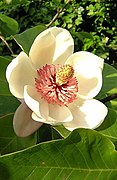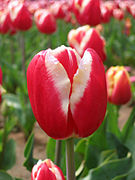| Revision as of 09:34, 1 October 2006 editDanny-w (talk | contribs)Extended confirmed users908 editsmNo edit summary← Previous edit | Latest revision as of 09:43, 24 October 2024 edit undoPeter coxhead (talk | contribs)Autopatrolled, Extended confirmed users, Page movers, Pending changes reviewers, Rollbackers, Template editors204,351 edits Undid revision 1253090069 by 2409:4042:2C47:F6B5:653B:A290:B9E8:1A20 (talk) original is the normal style and approach hereTag: Undo | ||
| (134 intermediate revisions by 68 users not shown) | |||
| Line 1: | Line 1: | ||
| {{Short description|One of the outer parts of a flower}} | |||
| {{Wiktionarypar|perianth}} | |||
| ] | |||
| {{sources}} | |||
| <!-- Image with unknown copyright status removed: ] flower showing the ]-like white '''tepals''']] --> | |||
| In a general sense, a '''tepal''' is an element of the '''perianth''' of a ], such as a ] or ]. The ''perianth'' comprises the outer, sterile whorls of a flower. The term ''tepal'' is usually used when all segments of a perianth are of similar shape and color (that is, undifferentiated). This happens in the family ] and a number of other primitive ]s such as the ]ceae and ]. | |||
| A '''tepal''' is one of the outer parts of a ] (collectively the ]). The term is used when these parts cannot easily be classified as either ]s or ]s. This may be because the parts of the perianth are undifferentiated (i.e. of very similar appearance), as in '']'', or because, although it is possible to distinguish an outer ] of sepals from an inner whorl of petals, the sepals and petals have similar appearance to one another (as in '']''). The term was first proposed by ] in 1827 and was constructed by ] with the terms "petal" and "sepal".<ref>{{cite book|url=https://www.biodiversitylibrary.org/item/60660#page/527/mode/1up|title=Organographie végétale, ou Description raisonnée des organes des plantes; pour servir de suite et de développement a la théorie élémentaire de la botanique, et d'introduction a la physiologie végétale et a la physiologie végétale et a la description des familles|author=Augustin Pyramus de Candolle |year=1827|publisher=Deterville|location=Paris|page=503}}</ref><ref>{{cite book|author=Augustin Pyramus de Candolle|year=1841|title=Vegetable organography; or, An analytical description of the organs of plants|translator=Boughton Kingdon|volume=2|page=90|url=https://www.biodiversitylibrary.org/item/70328#page/104/mode/1up|publisher=Houlston & Stoneman|location=London}}</ref> (De Candolle used the term ''perigonium'' or ''perigone'' for the tepals collectively; today, this term is used as a synonym for ''perianth''.)<ref name=Stea04>{{Cite book |last=Stearn |first=William Thomas |year=2004 |title=Botanical Latin |edition=p/b |publisher=David & Charles/Timber Press |isbn=978-0-7153-1643-6 }} p. 39.</ref> | |||
| === Merosity === | |||
| '''Merosity''' is a property of whorls of floral perianths that relates how many ]s a whorl of that particular plant has. Types of merosity, according to number of tepals in a perianth whorl, include: | |||
| == Origin == | |||
| *] (2) | |||
| ]'' flower showing the six '''tepals''': the outer three are sepals and the inner three are petals.]] | |||
| *] (3) | |||
| Undifferentiated tepals are believed to be the ancestral condition in ]s. For example, '']'', which is thought to have separated earliest in the evolution of flowering plants,<ref>{{Cite journal | last1 = Ronse De Craene | first1 = L. P. | title = Are Petals Sterile Stamens or Bracts? The Origin and Evolution of Petals in the Core Eudicots | doi = 10.1093/aob/mcm076 | journal = Annals of Botany | volume = 100 | issue = 3 | pages = 621–630 | year = 2007 | pmid = 17513305| pmc =2533615 }}</ref> has flowers with undifferentiated tepals. Distinct petals and sepals would therefore have arisen by differentiation, probably in response to animal ]. In typical modern flowers, the outer or enclosing whorl of organs forms sepals, specialised for protection of the flower bud as it develops, while the inner whorl forms petals, which attract ]s. | |||
| *] (4) | |||
| *] (5) | |||
| Tepals formed by similar sepals and petals are common in ]s, particularly the "]s". In ]s, for example, the first and second whorls both contain structures that look like petals. These are fused at the base to form one large, showy, six-parted structure (the perianth). In ] the organs in the first whorl are separate from the second, but all look similar, thus all the showy parts are often called tepals. Where sepals and petals can in principle be distinguished, usage of the term "tepal" is not always consistent – some authors will refer to "sepals and petals" where others use "tepals" in the same context. | |||
| These nouns for the different types of merosity are formed by a prefix derived from ] (e.g. ''tetra-'' for four tepals) and the suffixed root, ''-mery'', which is derived from Greek ''meros'' meaning "part". | |||
| In some plants the flowers have no petals, and all the tepals are sepals modified to look like petals. These organs are described as ], for example, the sepals of ]s. When the undifferentiated tepals resemble petals, they are also referred to as "petaloid", as in ], orders of monocots with brightly coloured tepals. Since they include ], an alternative name is lilioid monocots. | |||
| ⚫ | ] | ||
| == Properties and shape == | |||
| ] | |||
| Terms used in the description of tepals include pubescent (with dense fine, short, soft hairs, downy), puberulent (minutely pubescent, hairs barely visible to the naked eye) and puberulous (dense covering of very short soft hairs). Tepal shape is described in similar terms to those used for leaves (see ]). | |||
| ] | |||
| ] | |||
| == Gallery == | |||
| ] | |||
| <gallery widths="200px" heights="180px" caption="Flowers with tepals"> | |||
| ] | |||
| File:Magnolia-x-alba-bud-comparison.jpg|Flowers of ] showing tepals in various stages of development | |||
| File:Magnolia wieseneri.jpg|Tepals of ] | |||
| File:2006-12-18Helleborus_niger19.jpg|A ] flower showing the petaloid sepals | |||
| File:Sternbergia lutea showing the different parts of the flower.JPG|A '']'' flower showing the two whorls of tepals | |||
| File:Tulip_-_floriade_canberra02.jpg|A tulip flower showing the petal-like tepals | |||
| File:Blandfordia_nobilis_Berowra_Valley.JPG|Tepals of '']'', another ] | |||
| File:Juncus.squarrosus3.-.lindsey.jpg|6 tepals (3 inner, 3 outer) of the rush '']'' | |||
| </gallery> | |||
| ==See also== | |||
| * ] | |||
| * ] | |||
| ==References== | |||
| {{Reflist}} | |||
| *''Botany: A Brief Introduction To Plant Biology'' - 5th ed. Thomas L. Rost; T. Elliot Weier - Wiley & Sons 1979 {{ISBN|0-471-02114-8}}. | |||
| *''Plant Systematics'' - Jones; Samuel - McGraw-Hill 1979 {{ISBN|0-07-032795-5}}. | |||
| {{botany}} | |||
| ⚫ | ] | ||
Latest revision as of 09:43, 24 October 2024
One of the outer parts of a flower
A tepal is one of the outer parts of a flower (collectively the perianth). The term is used when these parts cannot easily be classified as either sepals or petals. This may be because the parts of the perianth are undifferentiated (i.e. of very similar appearance), as in Magnolia, or because, although it is possible to distinguish an outer whorl of sepals from an inner whorl of petals, the sepals and petals have similar appearance to one another (as in Lilium). The term was first proposed by Augustin Pyramus de Candolle in 1827 and was constructed by analogy with the terms "petal" and "sepal". (De Candolle used the term perigonium or perigone for the tepals collectively; today, this term is used as a synonym for perianth.)
Origin

Undifferentiated tepals are believed to be the ancestral condition in flowering plants. For example, Amborella, which is thought to have separated earliest in the evolution of flowering plants, has flowers with undifferentiated tepals. Distinct petals and sepals would therefore have arisen by differentiation, probably in response to animal pollination. In typical modern flowers, the outer or enclosing whorl of organs forms sepals, specialised for protection of the flower bud as it develops, while the inner whorl forms petals, which attract pollinators.
Tepals formed by similar sepals and petals are common in monocotyledons, particularly the "lilioid monocots". In tulips, for example, the first and second whorls both contain structures that look like petals. These are fused at the base to form one large, showy, six-parted structure (the perianth). In lilies the organs in the first whorl are separate from the second, but all look similar, thus all the showy parts are often called tepals. Where sepals and petals can in principle be distinguished, usage of the term "tepal" is not always consistent – some authors will refer to "sepals and petals" where others use "tepals" in the same context.
In some plants the flowers have no petals, and all the tepals are sepals modified to look like petals. These organs are described as petaloid, for example, the sepals of hellebores. When the undifferentiated tepals resemble petals, they are also referred to as "petaloid", as in petaloid monocots, orders of monocots with brightly coloured tepals. Since they include Liliales, an alternative name is lilioid monocots.
Properties and shape
Terms used in the description of tepals include pubescent (with dense fine, short, soft hairs, downy), puberulent (minutely pubescent, hairs barely visible to the naked eye) and puberulous (dense covering of very short soft hairs). Tepal shape is described in similar terms to those used for leaves (see Glossary of leaf morphology).
Gallery
- Flowers with tepals
-
 Flowers of Magnolia × alba showing tepals in various stages of development
Flowers of Magnolia × alba showing tepals in various stages of development
-
 Tepals of Magnolia × wieseneri
Tepals of Magnolia × wieseneri
-
 A hellebore flower showing the petaloid sepals
A hellebore flower showing the petaloid sepals
-
A Sternbergia lutea flower showing the two whorls of tepals
-
 A tulip flower showing the petal-like tepals
A tulip flower showing the petal-like tepals
-
Tepals of Blandfordia nobilis, another lilioid monocot
-
 6 tepals (3 inner, 3 outer) of the rush Juncus squarrosus
6 tepals (3 inner, 3 outer) of the rush Juncus squarrosus
See also
References
- Augustin Pyramus de Candolle (1827). Organographie végétale, ou Description raisonnée des organes des plantes; pour servir de suite et de développement a la théorie élémentaire de la botanique, et d'introduction a la physiologie végétale et a la physiologie végétale et a la description des familles. Paris: Deterville. p. 503.
- Augustin Pyramus de Candolle (1841). Vegetable organography; or, An analytical description of the organs of plants. Vol. 2. Translated by Boughton Kingdon. London: Houlston & Stoneman. p. 90.
- Stearn, William Thomas (2004). Botanical Latin (p/b ed.). David & Charles/Timber Press. ISBN 978-0-7153-1643-6. p. 39.
- Ronse De Craene, L. P. (2007). "Are Petals Sterile Stamens or Bracts? The Origin and Evolution of Petals in the Core Eudicots". Annals of Botany. 100 (3): 621–630. doi:10.1093/aob/mcm076. PMC 2533615. PMID 17513305.
- Botany: A Brief Introduction To Plant Biology - 5th ed. Thomas L. Rost; T. Elliot Weier - Wiley & Sons 1979 ISBN 0-471-02114-8.
- Plant Systematics - Jones; Samuel - McGraw-Hill 1979 ISBN 0-07-032795-5.
| Botany | |||||||||||
|---|---|---|---|---|---|---|---|---|---|---|---|
| Subdisciplines | |||||||||||
| Plant groups | |||||||||||
| Plant anatomy |
| ||||||||||
| Plant physiology Materials | |||||||||||
| Plant growth and habit | |||||||||||
| Reproduction | |||||||||||
| Plant taxonomy | |||||||||||
| Practice | |||||||||||
| |||||||||||